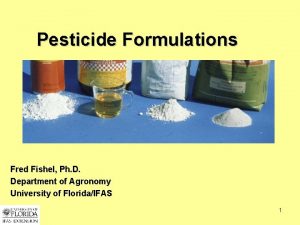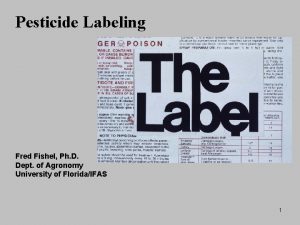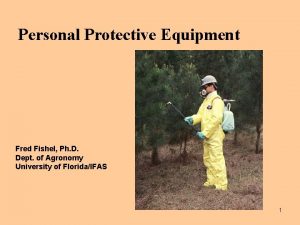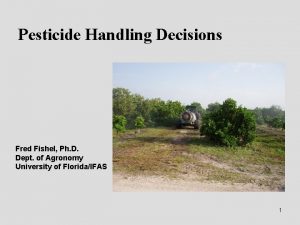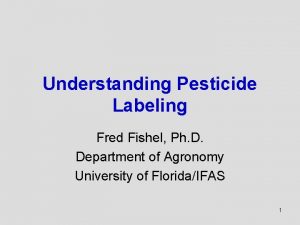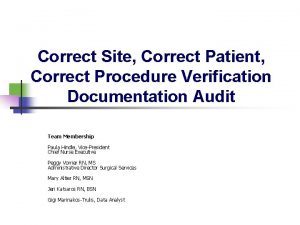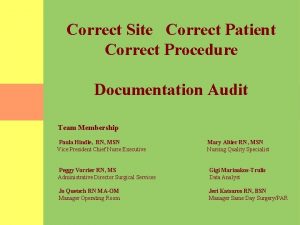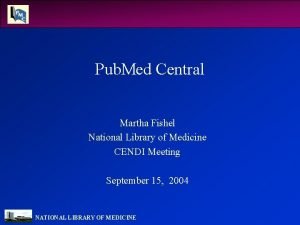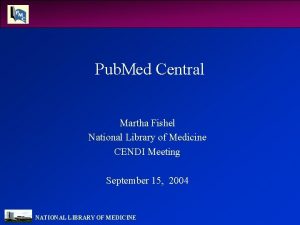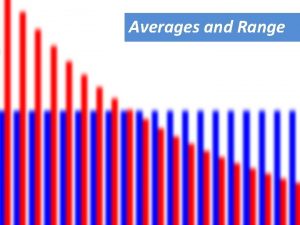Applying the Correct Amount Fred Fishel Ph D






















- Slides: 22

Applying the Correct Amount Fred Fishel, Ph. D. Dept. of Agronomy University of Florida/IFAS 1

Information that will be presented throughout this presentation is based upon Unit 10 in the Florida Core Manual, Applying Pesticides Correctly. You can purchase a copy to keep on hand for a reference from the IFAS Extension Bookstore. 2

One of the most important things for an applicator to do is make sure the right amount is being applied. 3

Apply the Right Dose • Underdosing is expensive – poor results and repeat applications • Overdosing is expensive – crop injury, excessive residues and illegal 4

Study the “Directions for Use” section of the label to determine how much of the pesticide to apply. 5

How are Rates Expressed? • By formulation (1 pint product per acre) • By active ingredient (1 pint active per acre) • Percent dilution (1% by volume) • Ready-to-use products (spray until foliage is wet) 6

You must determine how you will deliver the correct amount. 7

No calibration, mixing or loading needed (ready-to-use products) 8

No calibration or mixing but loading needed (ready-to-use products that must be put into application equipment) 9

No mixing but loading and calibration needed (granules and dusts) 10

Mixing and loading but no calibration needed (products that are applied to the “point of run -off” or animal dips) 11

Mixing, loading and calibration needed – most common situation (concentrate diluted, loaded and calibrated) 12

Proper calibration is an essential but often neglected task. It simply refers to determining the sprayer output per unit area. 13

Getting Started • Choosing the equipment is the first step – Designed for the formulation being applied – Appropriate for size and type of job 14

Getting Started • If using a sprayer: Determine field speed Determine pressure Determine nozzle tip size, type, orientation and spacing 15

Manufacturers will recommend various nozzles depending on the type of job and conditions. 16

Sprayer calibration consists of three major steps: 1) Ensure a uniform discharge from each nozzle tip. 17

Sprayer calibration consists of three major steps: 2) Operate the sprayer over a set distance. 18

Sprayer calibration consists of three major steps: 3) Refill the tank and determine how much water was applied over the measured area and convert to gpa. 19

Check calibration often to maintain accuracy. 20

Now you’re ready to add the pesticide to the tank. Based on output and tank capacity, add the labeled amount of pesticide to the spray tank. 21

Photo Credits • • • University of Missouri Virginia Tech University of Arizona University of Georgia Penn State University Spraying Systems Company Mention of trade names in this presentation is solely for providing specific information. It is not a guarantee or warranty of the products named, and does not signify that they are approved to the exclusion of others of suitable composition. Use pesticides safely. Read and follow directions on the manufacturer’s label. Fred Fishel, Ph. D. Department of Agronomy University of Florida/IFAS Copyright 2005 University of Florida 22
 Gene fishel
Gene fishel Stephanie fishel
Stephanie fishel Stephen fishel
Stephen fishel đặc điểm cơ thể của người tối cổ
đặc điểm cơ thể của người tối cổ Tỉ lệ cơ thể trẻ em
Tỉ lệ cơ thể trẻ em Dạng đột biến một nhiễm là
Dạng đột biến một nhiễm là Các châu lục và đại dương trên thế giới
Các châu lục và đại dương trên thế giới Thiếu nhi thế giới liên hoan
Thiếu nhi thế giới liên hoan Thẻ vin
Thẻ vin Môn thể thao bắt đầu bằng chữ f
Môn thể thao bắt đầu bằng chữ f điện thế nghỉ
điện thế nghỉ Cái miệng bé xinh thế chỉ nói điều hay thôi
Cái miệng bé xinh thế chỉ nói điều hay thôi Hát kết hợp bộ gõ cơ thể
Hát kết hợp bộ gõ cơ thể Mật thư anh em như thể tay chân
Mật thư anh em như thể tay chân Trời xanh đây là của chúng ta thể thơ
Trời xanh đây là của chúng ta thể thơ Sơ đồ cơ thể người
Sơ đồ cơ thể người Ví dụ về giọng cùng tên
Ví dụ về giọng cùng tên Chó sói
Chó sói Bảng số nguyên tố lớn hơn 1000
Bảng số nguyên tố lớn hơn 1000 Thơ thất ngôn tứ tuyệt đường luật
Thơ thất ngôn tứ tuyệt đường luật Thế nào là hệ số cao nhất
Thế nào là hệ số cao nhất ưu thế lai là gì
ưu thế lai là gì Slidetodoc
Slidetodoc
























